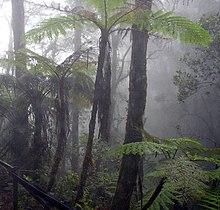
Back Humiditeit Afrikaans رطوبة الهواء Arabic আৰ্দ্ৰতা Assamese Humedá AST Rütubət Azerbaijani Дымлылыҡ Bashkir Luaftfeichtigkeit BAR Вільготнасць паветра Byelorussian Вільготнасьць паветра BE-X-OLD Влажност на въздуха Bulgarian
| Humidity and hygrometry |
|---|
 |
| Specific concepts |
| General concepts |
| Measures and instruments |

Humidity is the concentration of water vapor present in the air. Water vapor, the gaseous state of water, is generally invisible to the human eye.[2] Humidity indicates the likelihood for precipitation, dew, or fog to be present.
Humidity depends on the temperature and pressure of the system of interest. The same amount of water vapor results in higher relative humidity in cool air than warm air. A related parameter is the dew point. The amount of water vapor needed to achieve saturation increases as the temperature increases. As the temperature of a parcel of air decreases it will eventually reach the saturation point without adding or losing water mass. The amount of water vapor contained within a parcel of air can vary significantly. For example, a parcel of air near saturation may contain 28 g of water per cubic metre of air at 30 °C (86 °F), but only 8 g of water per cubic metre of air at 8 °C (46 °F).
Three primary measurements of humidity are widely employed: absolute, relative, and specific. Absolute humidity is expressed as either mass of water vapor per volume of moist air (in grams per cubic meter)[3] or as mass of water vapor per mass of dry air (usually in grams per kilogram).[4] Relative humidity, often expressed as a percentage, indicates a present state of absolute humidity relative to a maximum humidity given the same temperature. Specific humidity is the ratio of water vapor mass to total moist air parcel mass.
Humidity plays an important role for surface life. For animal life dependent on perspiration (sweating) to regulate internal body temperature, high humidity impairs heat exchange efficiency by reducing the rate of moisture evaporation from skin surfaces. This effect can be calculated using a heat index table, or alternatively using a similar humidex.
The notion of air "holding" water vapor or being "saturated" by it is often mentioned in connection with the concept of relative humidity. This, however, is misleading—the amount of water vapor that enters (or can enter) a given space at a given temperature is almost independent of the amount of air (nitrogen, oxygen, etc.) that is present. Indeed, a vacuum has approximately the same equilibrium capacity to hold water vapor as the same volume filled with air; both are given by the equilibrium vapor pressure of water at the given temperature.[5][6] There is a very small difference described under "Enhancement factor" below, which can be neglected in many calculations unless great accuracy is required.
- ^ Brun, Philipp; Zimmermann, Niklaus E.; Hari, Chantal; Pellissier, Loïc; Karger, Dirk N. (2022-06-27). "Global climate-related predictors at kilometre resolution for the past and future" (PDF). ESSD – Land/Biogeosciences and biodiversity. doi:10.5194/essd-2022-212. Archived (PDF) from the original on Jan 8, 2023.
- ^ "What is water vapor?". WeatherQuestions.com. Archived from the original on 2019-03-11. Retrieved 2012-08-28.
- ^ Wyer, Samuel S. (1906). "Fundamental Physical Laws and Definitions". A Treatise on Producer-Gas and Gas-Producers. McGraw-Hill Book Company. p. 23.
- ^ Perry, R.H. and Green, D.W, (2007) Perry's Chemical Engineers' Handbook (8th Edition), Section 12, Psychrometry, Evaporative Cooling and Solids Drying McGraw-Hill, ISBN 978-0-07-151135-3
- ^ Cite error: The named reference
Babinwas invoked but never defined (see the help page). - ^ Cite error: The named reference
psu.eduwas invoked but never defined (see the help page).
© MMXXIII Rich X Search. We shall prevail. All rights reserved. Rich X Search